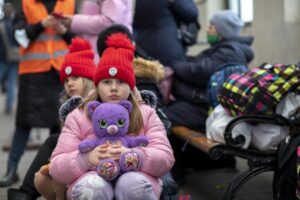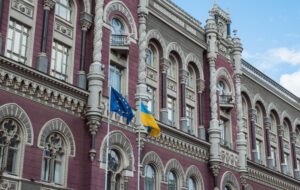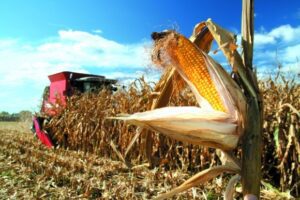
The relevant bill will be considered in the Bundestag.
If adopted, from June 1, 2022, citizens of Ukraine who have received a residence permit in accordance with the law on the stay of foreigners will receive social assistance in the amount of 449 euros. Now the amount of payments is about 300 euros. More than 400,000 Ukrainian refugees have already arrived in Germany, and about 3,000 more are arriving every day, according to the Ukraine Round Table held in Berlin on Monday with the participation of German Chancellor Olaf Scholz.
According to the information, more than 60 thousand Ukrainian schoolchildren are already studying in Germany, and graduates of Ukrainian schools were allowed to enter German universities without a diploma. According to the UN data, as of 13:00 on April 24, a total of 5.23 million people left Ukraine since the beginning of the war (excluding the entry flow), of which 2.91 million went to Poland, 843.74 thousand to Romania and Moldova. , Russia – 605.82 thousand, Hungary – 492.98 thousand, Slovakia – 355.59 thousand, Belarus – 24.48 thousand.
At the same time, according to the State Border Service, 1.17 million people have entered Ukraine by this date since February 28.

The National Bank of Ukraine (NBU) is recording the adaptation and gradual recovery of the economy after its collapse in the first weeks of the war, said Volodymyr Lepushinsky, director of the NBU’s Department of Monetary Policy and Economic Analysis.
“It’s hard for the economy, but it adapts and works. As the main destructive factor – the Russian occupiers – is eliminated, it is recovering. If in March 10 regions and Kyiv were covered by occupation and active hostilities, which produced 55% of GDP, now it is six regions and 20% of GDP, respectively,” he wrote in a column published on the website of the Interfax-Ukraine agency on Friday.
Among the main processes that indicate recovery, Lepushinsky called the almost halving of the number of enterprises that completely stopped their activity – from 32% to 17%, although 60% of enterprises are still operating below the pre-war level of workload.
According to the NBU operational surveys, almost a third of enterprises now do not experience problems with a lack of resources at all, and 48% of those surveyed will have enough available resources for more than a month, thus, compared to March, the share of businesses in which stocks have run out has decreased.
Lepushinsky added that metallurgy is starting to work, mechanical engineering is being activated, the food industry is operating at full capacity in relatively calm regions and is being restored in the liberated territories.
According to him, the labor market is gradually recovering, although the number of job seekers is growing faster than the number of vacancies, which leads to lower wages. “Less wages are an unpleasant consequence of the war. However, now it is important that the labor market is functioning and allows businesses to adapt and find workers,” said the representative of the regulator.
He also pointed out that the National Bank will continue to pause in the publication of the Inflation Report with a macroeconomic forecast until the economic situation normalizes.
“War is almost the only good reason to pause macroeconomic forecasting. Given that additional sources of uncertainty are attached – the duration and consequences of hostilities – it is impossible to make accurate forecasts today,” Lepushinsky explained.
According to him, in order to keep abreast, the NBU has stepped up work on the search and processing of alternative data, as the number of official data has narrowed.
“With the current intensity of events, only the most obvious trends that determine the development of the economy should be determined. After the uncertainty is reduced, forecast scenarios will be “strung” on such trends,” wrote the director of the NBU’s Department of Monetary Policy and Economic Analysis.
He clarified that the National Bank expects that GDP will fall by at least a third this year, and losses could be greater if active hostilities drag on.
One of the reasons for this fall Lepushinsky called the destruction of the most important infrastructure, production, real estate and valuable movable property. According to the latest NBU estimates, the loss of physical capital is about $100 billion, or half of Ukraine’s total GDP for 2021, the column notes.
Among other factors, the author named the lack of internal sources for such a significant increase in capital, although he considers it quite reasonable to hope for external sources both at the expense of confiscated Russian assets and thanks to the support of international organizations, the EU and bilateral assistance from countries.
Lepushinsky pointed out the labor force as another reason, since, according to UN estimates, 5 million people left the country, and at the initial stage of recovery, due to the disruption of communications, the destruction of production and logistics, the demand for labor will be low, which will lead to a high level of unemployment and put pressure on wages.
“However, with the resumption and growth of production capacity, the situation will change: the demand for labor will grow and lead to higher wages. An important role will be played by measures to stimulate the return of migrants to Ukraine, for example, through tax incentives and retraining measures,” the NBU representative said.

The first cargo of Ukrainian corn weighing 71,000 tons since the beginning of the Russian military invasion of Ukraine went on a P-class vessel to the recipient from the Black Sea port of Constanta (Romania), the Reuters website reported on Friday.
According to him, this port has already received about 80 thousand tons of Ukrainian grain, and the same number is on the way to it.
As Ukraine’s seaports were blocked following Russia’s aggressor country’s invasion of Ukraine in February, the world’s fourth-largest grain exporter has been forced to ship to Romania by train across its western border or through its small river ports on the Danube River.
“Supporting the export of Ukrainian grain means preventing a colossal wave of world hunger provoked by the blockade of Ukrainian ports. Compared to the initial moment, when everyone was looking for alternative transport corridors for grain exports, they are gradually being formed,” Viorel Panaita, president of Comvex port operator, who organized deliveries of a batch of Ukrainian corn.
According to Comvex, the seaport of Constanta owns the fastest-loading grain terminal in Europe, capable of handling up to 70,000 tons of crops per day.
As reported, Ukrainian and Romanian ministries at the end of March began negotiations on the export of agricultural products from Ukraine through European seaports, including the Romanian port of Constanta.
Ukraine has tens of millions of tons of agricultural products in warehouses, but due to a naval blockade by the aggressor country, the Russian Federation cannot supply it to its traditional markets.
The countries bordering Ukraine have responded to its problem with the export of agricultural products, and have already significantly simplified the procedures for registering freight traffic or are actively working on it. In particular, Romania, Slovakia, Hungary, Lithuania, Latvia, Estonia, as well as Italy, Turkey, Bulgaria, Georgia, Denmark, Greece, Austria introduced liberal conditions for Ukrainian carriers.
Before the Russian military invasion, Ukraine monthly exported about 5 million tons of agricultural products through the ports of Odessa and Nikolaev, but now, due to their naval blockade by the Russian Federation, it can transport about 500 thousand tons of grain monthly. This leads to a monthly shortfall of about $1.5 billion in export earnings for the country.

Since the end of February, Adonis Medical Group has not stopped working, and is currently resuming the work of clinics, Adonis general director Vitaliy Hyrin told Interfax-Ukraine.
He said that during this time the clinic branches in Podil and Sofiyivska Borschahivka, as well as emergency ambulances, worked around the clock.
In addition, from April 8, the maternity hospital of the network resumed work on the left bank.
“On May 9, we plan to open a maternity hospital on the right bank at the Shalimov branch. Currently, all branches are operating, except for the maternity hospital in Buzova, which was significantly damaged by shelling, as well as the branch in Bucha,” he said.
Hyrin noted a significant increase in the number of requests for medical help in recent years.
“In early March, there was a strong decline, but from mid-March and in April, the number of visits to Adonis clinics increased by 2.5 times and continues to grow,” he said.
According to Hyrin, the main specialties for patients are gynecology, pregnancy management, childbirth, prenatal and general ultrasound, sampling, pediatrics and therapy.
He also said that a significant number of Adonis patients are not located in Kyiv and are being consulted online.
Adonis is a network of private medical centers for adults and children founded over 20 years ago. It includes 12 branches in Kyiv and the region, including two own maternity hospitals and a stem cell laboratory.
In the branches of the clinic, doctors treat patients in 66 medical specialties.

The German chemical company BASF SE, one of the largest in the world, intends to curtail all activities in Russia and Belarus by July, except for the production of additives for the food industry.
“The Board of Executive Directors of BASF SE has also decided by early July 2022 to curtail the remaining business activities of the company in Russia and Belarus. Businesses that support food production are exempted from this decision, as the war risks provoking a global food crisis,” the company said in a statement.
In early March, against the backdrop of the war started by Russia in Ukraine, the company announced the abandonment of new projects in Russia and Belarus. The company is now developing detailed plans for an orderly winding down.
It is noted that in 2021, the revenue of the group’s companies in Russia and Belarus amounted to about 1% of the total sales of BASF Group (78.6 billion euros). Now 684 BASF employees work in these countries. The company intends to support them until the end of 2022.
BASF operates through six core business segments: Chemicals, Materials, Industrial Solutions, Surface Technology, Nutrition & Care, and Agricultural Solutions.